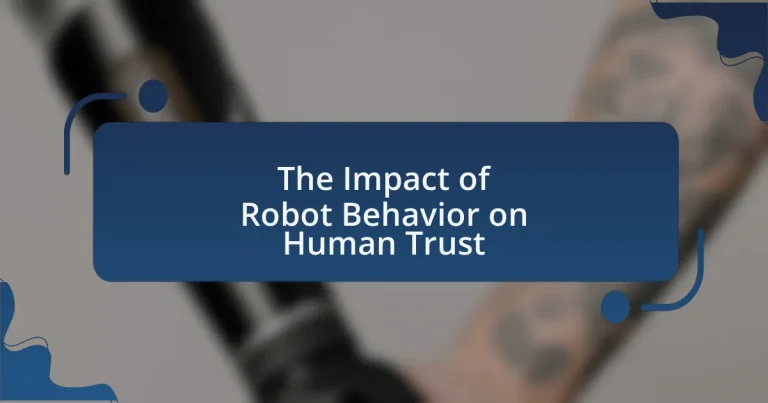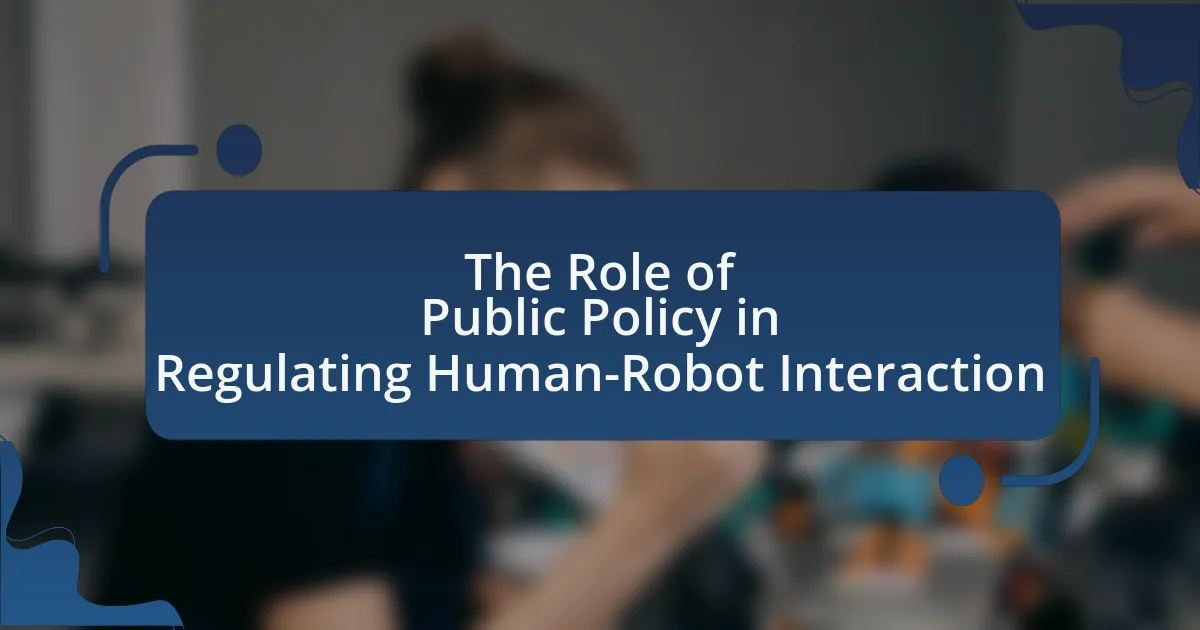The article examines the significant impact of robot behavior on human trust, highlighting how consistent, predictable, and transparent actions foster user confidence in robotic systems. Key factors influencing trust include reliability, transparency, and social engagement, with research indicating that robots exhibiting human-like behaviors and emotional responses enhance trust levels. The article also explores the implications of trust in robotic interactions, the consequences of low trust, and the role of cultural differences in shaping perceptions of robotic behavior. Strategies for enhancing trust, such as user-centered design and effective communication, are discussed, emphasizing the importance of understanding robot behavior to improve user acceptance and collaboration.

What is the Impact of Robot Behavior on Human Trust?
Robot behavior significantly influences human trust, as consistent and predictable actions foster confidence in robotic systems. Research indicates that when robots exhibit reliable and transparent behavior, users are more likely to trust them; for instance, a study published in the journal “Human-Computer Interaction” by Lee et al. (2010) found that participants displayed higher trust levels in robots that communicated their intentions clearly. Conversely, erratic or unpredictable behavior can lead to distrust, as evidenced by findings from the “International Journal of Social Robotics,” which highlighted that robots failing to meet user expectations diminished trust. Thus, the impact of robot behavior on human trust is profound, with clear evidence supporting the correlation between reliability and user confidence.
How do robots influence human perceptions of trust?
Robots influence human perceptions of trust primarily through their behavior and design. Research indicates that humans are more likely to trust robots that exhibit social cues, such as eye contact and responsive interactions, which mimic human-like behavior. For instance, a study published in the journal “Science Robotics” by Riek and Howard (2014) found that robots displaying friendly gestures and appropriate emotional responses significantly increased trust levels among users. Additionally, the predictability and reliability of a robot’s actions contribute to trust; when robots perform tasks consistently and transparently, users develop a stronger sense of confidence in their capabilities.
What factors contribute to trust in robotic systems?
Factors that contribute to trust in robotic systems include reliability, transparency, and predictability. Reliability refers to the system’s consistent performance and ability to complete tasks without failure, which builds confidence in users. Transparency involves clear communication about the robot’s capabilities and limitations, allowing users to understand how decisions are made. Predictability relates to the robot’s behavior being consistent and understandable, enabling users to anticipate actions and outcomes. Research indicates that these factors significantly influence user trust, as demonstrated in studies where users reported higher trust levels in robots that exhibited reliable and transparent behaviors.
How does robot behavior affect user confidence?
Robot behavior significantly affects user confidence by influencing perceptions of reliability and competence. When robots exhibit consistent, predictable actions, users are more likely to trust their capabilities, as demonstrated in studies where participants reported higher confidence levels in robots that followed established protocols and displayed human-like social cues. For instance, research published in the journal “Human-Computer Interaction” found that robots demonstrating empathy and responsiveness increased user trust, leading to a more positive interaction experience. This correlation between robot behavior and user confidence underscores the importance of designing robots that can effectively communicate and behave in ways that align with user expectations.
Why is understanding robot behavior important for trust?
Understanding robot behavior is crucial for establishing trust because predictable and transparent actions foster user confidence. When users can anticipate how a robot will behave in various situations, they are more likely to rely on it for assistance. Research indicates that consistent behavior patterns in robots lead to higher trust levels among users, as seen in studies where participants reported increased comfort with robots that displayed clear and understandable actions. For instance, a study published in the journal “Human-Robot Interaction” found that robots exhibiting human-like social cues significantly improved trust levels in users, demonstrating the importance of behavior comprehension in building trust.
What role does predictability play in building trust?
Predictability is crucial in building trust as it establishes a reliable framework for interactions. When individuals can anticipate behaviors and responses, they feel more secure in their relationships, whether with people or robots. Research indicates that consistent and predictable actions lead to higher levels of trust, as seen in studies where participants reported increased trust in robots that exhibited stable and expected behaviors. For instance, a study by Lee et al. (2010) demonstrated that users were more likely to trust robots that followed predictable patterns in their actions, reinforcing the idea that predictability fosters a sense of safety and reliability essential for trust development.
How do emotional responses to robots impact trust levels?
Emotional responses to robots significantly impact trust levels, as positive emotions foster greater trust while negative emotions diminish it. Research indicates that when humans perceive robots as friendly or empathetic, their trust in these machines increases, leading to more effective collaboration and acceptance of robotic assistance. For instance, a study published in the journal “Human-Computer Interaction” by Bartneck et al. (2009) found that participants who interacted with robots displaying positive emotional cues reported higher trust levels compared to those who interacted with robots exhibiting neutral or negative behaviors. This correlation underscores the importance of emotional design in robotics, as it directly influences user trust and acceptance.
What are the implications of trust in robotic interactions?
Trust in robotic interactions significantly influences user acceptance and the effectiveness of robots in various applications. When users trust robots, they are more likely to engage with them, leading to improved collaboration and outcomes in settings such as healthcare, manufacturing, and personal assistance. Research indicates that trust is built through consistent and reliable robot behavior, transparency in operations, and the ability to communicate effectively with users. For instance, a study by Lee and See (2004) highlights that perceived reliability and predictability in robot actions enhance user trust, which in turn fosters a more positive interaction experience. Thus, the implications of trust in robotic interactions are critical for the successful integration of robots into everyday life and professional environments.
How does trust affect user acceptance of robots?
Trust significantly influences user acceptance of robots, as higher levels of trust lead to increased willingness to use robotic systems. Research indicates that when users perceive robots as reliable, competent, and safe, they are more likely to accept and engage with them. For instance, a study by Lee and See (2004) found that trust in automation directly correlates with user acceptance, highlighting that users are more inclined to adopt robotic technologies when they believe in their effectiveness and safety. This relationship underscores the importance of designing robots that foster trust through transparent communication, consistent performance, and user-friendly interactions.
What are the consequences of low trust in robotic systems?
Low trust in robotic systems leads to reduced user engagement and reliance on these technologies. When individuals lack confidence in robots, they are less likely to utilize them for tasks, which can hinder efficiency and productivity. For instance, a study published in the journal “Robotics and Autonomous Systems” found that low trust significantly decreased the likelihood of users following robotic instructions, resulting in suboptimal outcomes in collaborative environments. Additionally, low trust can lead to increased anxiety and resistance towards adopting robotic solutions, ultimately stalling technological advancement and integration in various sectors.

How do Different Robot Behaviors Affect Human Trust?
Different robot behaviors significantly influence human trust levels. For instance, robots that exhibit consistent and predictable behaviors tend to foster higher trust among users, as demonstrated in studies where participants reported increased confidence in robots that followed established protocols. Conversely, erratic or unpredictable behaviors can lead to distrust, as users may feel uncertain about the robot’s reliability. Research by Lee et al. (2010) in “Human-Robot Interaction” highlights that robots displaying social cues, such as eye contact and friendly gestures, enhance trust by creating a sense of companionship and understanding. Thus, the manner in which robots behave directly correlates with the degree of trust humans place in them.
What types of robot behaviors are most influential on trust?
Robot behaviors that are most influential on trust include transparency, reliability, and social engagement. Transparency in a robot’s actions and decision-making processes fosters trust by allowing users to understand how the robot operates. Reliability, demonstrated through consistent performance and predictable responses, reinforces user confidence in the robot’s capabilities. Social engagement, characterized by the robot’s ability to communicate effectively and respond to human emotions, enhances interpersonal connections and trust. Research by Lee et al. (2010) in “Trust in Human-Robot Interaction” highlights that these behaviors significantly impact users’ willingness to rely on robots in various contexts.
How does cooperative behavior enhance trust?
Cooperative behavior enhances trust by fostering positive interactions and mutual reliance among individuals. When individuals engage in cooperative actions, they demonstrate reliability and a willingness to support one another, which builds a foundation of trust. Research indicates that cooperation leads to increased perceptions of competence and benevolence, essential components of trust. For instance, studies show that groups exhibiting cooperative behavior experience higher levels of trustworthiness ratings compared to those that do not cooperate, as seen in the work by Balliet and Van Lange (2013) in “Trust, Conflict, and Cooperation: A Meta-Analysis.” This evidence illustrates that cooperative behavior not only strengthens interpersonal relationships but also cultivates an environment where trust can flourish.
What impact does aggressive behavior have on trust levels?
Aggressive behavior significantly reduces trust levels. Research indicates that when individuals or entities exhibit aggressive behavior, it creates an environment of fear and uncertainty, leading to diminished trust. For instance, a study published in the Journal of Personality and Social Psychology found that aggressive interactions can lead to perceptions of threat, which in turn erode trust in relationships. This decline in trust is particularly pronounced in contexts involving robots, where aggressive actions can lead to negative perceptions and a reluctance to engage with robotic systems.
How do cultural differences influence trust in robots?
Cultural differences significantly influence trust in robots by shaping individuals’ perceptions and expectations of technology. For instance, in collectivist cultures, such as Japan, people may exhibit higher trust in robots due to a societal emphasis on harmony and collaboration, which aligns with the integration of robots in daily life. Conversely, in individualistic cultures like the United States, skepticism towards robots may arise from a focus on personal autonomy and a fear of losing control. Research by Hynes et al. (2019) in “Cultural Influences on Trust in Robots” highlights that cultural context affects how users interpret robot behavior, with varying levels of acceptance and reliance on robotic assistance. This evidence underscores that cultural background plays a crucial role in determining the degree of trust individuals place in robotic systems.
What behaviors are preferred in different cultural contexts?
Preferred behaviors in different cultural contexts vary significantly, influencing human interactions and trust in robots. For instance, in collectivist cultures like Japan, behaviors that emphasize harmony, group consensus, and indirect communication are favored, as they promote social cohesion. Conversely, in individualistic cultures such as the United States, assertiveness, direct communication, and personal achievement are more valued, fostering independence and self-expression. Research by Hofstede indicates that these cultural dimensions shape interpersonal relationships and trust dynamics, highlighting the importance of aligning robot behaviors with cultural expectations to enhance user trust and acceptance.
How can robots be designed to accommodate cultural variations in trust?
Robots can be designed to accommodate cultural variations in trust by integrating culturally relevant communication styles and behaviors. For instance, robots can be programmed to recognize and adapt to different cultural norms regarding eye contact, personal space, and formality in language, which significantly influence trust levels. Research indicates that in cultures with high-context communication, such as Japan, non-verbal cues are crucial for establishing trust, while in low-context cultures, like the United States, direct verbal communication is more valued. By employing machine learning algorithms that analyze user interactions and feedback, robots can continuously refine their approaches to align with the specific trust-building practices of diverse cultural groups.

What Strategies Can Enhance Trust in Robot Behavior?
To enhance trust in robot behavior, implementing transparency, consistency, and user engagement strategies is essential. Transparency involves clearly communicating the robot’s capabilities and limitations, which helps users understand its actions and decisions. Consistency in behavior reinforces predictability, allowing users to form reliable expectations about the robot’s responses. User engagement, through feedback mechanisms and customization options, fosters a sense of control and personal connection, further building trust. Research indicates that these strategies significantly improve user trust levels, as evidenced by studies showing that transparent robots are perceived as more trustworthy (Source: “Trust in Human-Robot Interaction,” authors: Bartneck et al., 2019).
How can transparency in robot actions build trust?
Transparency in robot actions builds trust by allowing users to understand the decision-making processes and behaviors of the robot. When users can see how a robot arrives at its conclusions or actions, they are more likely to feel confident in its reliability and intentions. Research indicates that transparency reduces uncertainty and fosters a sense of predictability, which are critical components of trust. For example, a study published in the journal “Human-Robot Interaction” found that participants who were informed about a robot’s reasoning were significantly more likely to trust the robot compared to those who were not given such information. This demonstrates that clear communication of a robot’s actions and rationale enhances user trust.
What information should robots provide to users?
Robots should provide users with clear, accurate, and relevant information regarding their functions, capabilities, and limitations. This transparency fosters trust, as users are more likely to rely on robots that communicate effectively about what they can and cannot do. For instance, studies have shown that when robots disclose their operational parameters and potential risks, user trust increases significantly, as evidenced by research conducted by Lee and See (2004) in “Trust in Automation: Designing for Appropriate Reliance.” This indicates that providing comprehensive information is essential for enhancing user confidence in robotic systems.
How does feedback from robots influence user trust?
Feedback from robots significantly influences user trust by providing reassurance and clarity regarding the robot’s actions and intentions. When robots deliver consistent and accurate feedback, users perceive them as more reliable and competent, which enhances trust. Research indicates that positive feedback from robots, such as successful task completion or clear communication, correlates with increased user confidence. For instance, a study published in the journal “Human-Computer Interaction” by Lee et al. (2018) found that users reported higher trust levels when robots effectively communicated their status and intentions during interactions. This demonstrates that effective feedback mechanisms are crucial for fostering trust between users and robotic systems.
What design principles can improve trust in robotic systems?
Design principles that can improve trust in robotic systems include transparency, predictability, and user-centered design. Transparency involves providing clear information about the robot’s capabilities and limitations, which helps users understand how the robot operates. Predictability ensures that the robot behaves in a consistent manner, allowing users to anticipate its actions and responses. User-centered design focuses on tailoring the robot’s interface and interactions to meet the needs and preferences of users, enhancing their comfort and confidence in using the system. Research has shown that these principles significantly enhance user trust, as evidenced by studies indicating that transparent and predictable robots are more likely to be accepted and trusted by users in various applications.
How can user-centered design enhance trustworthiness?
User-centered design enhances trustworthiness by prioritizing user needs and preferences, leading to more intuitive and satisfying interactions. When products or systems are designed with a deep understanding of users, they tend to be more reliable and easier to use, which fosters a sense of competence and safety. Research indicates that systems designed with user input result in higher user satisfaction and perceived reliability, as evidenced by a study published in the Journal of Usability Studies, which found that user-centered design practices significantly improved user trust in technology. This trust is crucial in contexts involving robots, where users are more likely to engage with and rely on systems that they find user-friendly and responsive to their needs.
What role does user training play in fostering trust?
User training plays a critical role in fostering trust by equipping individuals with the knowledge and skills necessary to effectively interact with robotic systems. When users receive comprehensive training, they develop a better understanding of the robot’s capabilities and limitations, which reduces uncertainty and enhances their confidence in the technology. Research indicates that well-trained users are more likely to perceive robots as reliable and competent, leading to increased trust levels. For instance, a study published in the journal “Human-Robot Interaction” found that participants who underwent structured training sessions reported significantly higher trust scores compared to those who did not receive any training. This demonstrates that effective user training directly correlates with improved trust in robotic systems.
What best practices can organizations implement to build trust in robots?
Organizations can build trust in robots by ensuring transparency, reliability, and user involvement in the design process. Transparency involves clearly communicating the robot’s capabilities and limitations, which helps users understand what to expect and reduces uncertainty. Reliability is achieved through consistent performance and safety measures, as studies show that users are more likely to trust robots that demonstrate dependable behavior. Additionally, involving users in the design and testing phases fosters a sense of ownership and familiarity, which can enhance trust. Research indicates that when users feel they have a say in the development of technology, their trust levels increase significantly.





